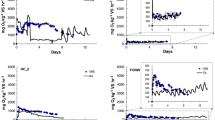Summary
The 5-day BODs of 45 organic chemicals were determined using acclimated mixed microbial cultures. These chemicals included alcohols, acids, esters, ketones, aromatics and miscellaneous compounds. The BOD data were correlated with (1) water solubilities, (2) log of 1-octanol/water partition coefficients, (3) molar refractivities and volumes, (4) melting (m.p.) and boiling points, (5) number of carbon (C No.), hydrogen and oxygen atoms, (6) molecular weights, and (7) theoretical (Th) BODs of chemicals. Linear and secondorder polynomial regression analyses were used; the latter was also attempted with two or more independent variables. All prediction equations were compared for statistical merits. The equations, one from each regression type, with the highest prediction power were: log 5-day mmol BOD/mmol chemical=(1)−0.183+0.813 (log ThBOD), (2)−0.391+1.560 (log ThBOD) −0.532 (log ThBOD)2, and (3) −0.4060+0.2470 (C No.) −0.0133 (C No.)2−0.0005 (m.p.). The measured BOD data for 43 additional chemicals were compared with the predicted values calculated through the above equations. The three equations predicted the BODs for 84–88% of the test chemicals within 80% of the experimental values. The mean percent relative standard deviations between predicted and experimental BOD values were statistically compared for these equations, and no significant difference (P≤0.01) in their predictive utility was found. The acclimation potential of an autochthonous microbial community cannot yet be predicted, but this study demonstrates that the process of active biodegradation for structurally dissimilar chemicals appears to correlate quantitatively with certain physicochemical parameters.
Similar content being viewed by others
References
American Public Health Association. 1980. Standard Methods for the Examination of Water and Wastewater. American Public Health Association, Washington, DC.
Banerjee, S., P.H. Howard, A.M. Rosenberg, A.E. Dombrowski, H. Sikka and D.L. Tullis. 1984. Development of a general kinetic model for biodegradation and its application to chlorophenols and related compounds. Environ. Sci. Technol. 18:416–422.
Boethling, R.S. and M. Alexander. 1979. Effect of concentration of organic chemicals on their biodegradation by natural microbial communities. Appl. Environ. Microbiol. 37: 1211–1216.
Geating, J. 1981. Literature Study of the Biodegradability of Chemicals in Water. Volume 1. Biodegradability Prediction, Advances in and Chemical Interferences with Wastewater Treatment. EPA Report 600/2-81-175. U.S. Environmental Protection Agency. Cincinnati, OH.
Hansch, C. and A. Leo. 1979. Substituent Constants for Correction Analysis in Chemistry and Biology. John Wiley and Sons, New York, NY.
Hunter, R., L. Faulkner, T. Kaiserski and D. Antonsen. 1984. The QSAR System. A structure activity based chemical modeling and information system. Montana State University, Bozeman, MT.
Leo A. and D. Weiniger. 1984. CLOGP Version 3.2 User Reference Manual. Medicinal Chemistry Project, Pomona College, Claramont, CA.
Lyman, W.J., W.F. Reehl and D.H. Rosenblatt, (eds.), 1982. Handbook of Chemical Property Estimation Methods. McGraw-Hill Book Co., New York, NY.
Minitab, Inc. 1985. Minitab Release 5.1, Minitab, Inc., State College, PA.
Niemi, G.J., G.D. Veith, R.R. Regal and D.D. Vaishnav. 1987. Structural features associated with degradable and persistent chemicals. Environ. Toxicol. Chem., in the press.
Organization for Economic Cooperation and Development (OECD). 1981. OECD Guidelines for Testing of Chemicals. Section 3 — Degradation and accumulation. OECD Publications Information Center, Washington, DC.
Paris, D.F., N.L. Wolfe and W.C. Steen. 1982. Structure activity relationships in microbial transformation of phenols. Appl. Environ. Microbiol. 44(1):153–158.
Paris, D.F., N.L. Wolfe and W.C. Steen. 1984. Microbial transformation of esters of chlorinated carboxylic acids. Appl. Environ. Microbiol. 47(1): 7–11.
Vaishnav, D.D. and D.M. Lopas. 1985. Relationship between lipophilicity and biodegradation inhibition of selected industrial chemicals. Dev. Ind. Microbiol. 26: 557–565.
Veith, G.D., D.J. Call and L.T. Brooke. 1983. Structure-toxicity relationships for the fathead minnow,Pimephales promelas: narcotic industrial chemicals. Can. J. Fish. Aquat. Sci. 40: 743–748.
Veith, G.D., D. DeFoe and M. Knuth. 1984. Structure-activity relationships for screening organic chemicals for potential ecotoxicity effects. Drug Metab. Rev. 15(7): 1295–1303.
Wolfe, N.L., D.F. Paris, W.C. Steen and G.L. Baughman. 1980. Correlation of microbial degradation rates with chemical structure. Environ. Sci. Technol. 14: 1143–1144.
Author information
Authors and Affiliations
Rights and permissions
About this article
Cite this article
Babeu, L., Vaishnav, D.D. Prediction of biodegradability for selected organic chemicals. Journal of Industrial Microbiology 2, 107–115 (1987). https://doi.org/10.1007/BF01569509
Received:
Revised:
Accepted:
Issue Date:
DOI: https://doi.org/10.1007/BF01569509




